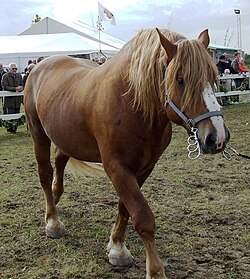Lithuanian cold blood
| Lithuanian cold blood | |
|---|---|

|
|
| Important data | |
| Origin: | Lithuania |
| Main breeding area: | Lithuania |
| Distribution: | |
| Stick measure : | 152-162 cm |
| Colors : | Brown, fox, black, gray |
| Main application area: | Draft / work horse, agricultural work, slaughter horse |
The Lithuanian draft horse , also known as the Lithuanian heavy draft horse , is a breed of cold blood horse from Lithuania , which was bred on the basis of the native landrace Žemaituka . The Lithuanian draft horse is bred in almost all parts of Lithuania.
Background information on horse evaluation and breeding can be found under: Exterior , interior and horse breeding .
Exterior
The Lithuanian draft horse has a rather coarse head that sits on a short and muscular neck. The physique is massive, the foundation strong. The long trunk and muscular chest are wide and deep. The wide, sloping croup is clearly split due to the pronounced gluteal muscles. The hind legs are sometimes cow-hocked or saber-legged. The coarse long hair is dense and wavy, the fur colors include foxes and browns, but also black horses and molds. The height of the Lithuanian draft horse is 152–162 cm.
interior
The Lithuanian draft horse has a friendly disposition and a high level of motivation. It is very suitable as a draft horse in agriculture and on the road. In contrast to other heavy cold-blooded breeds, it is characterized by a very agile gait. It is also a robust horse that is easy to care for, reaches a high age and is very fertile.
Breeding history
The original landrace of Lithuania is the Žemaitukas (the Zhmud horse ). He is in the Kleppertyp , a form of the house horse that was native to the entire Baltic Sea area. The breeding of the Lithuanian draft horse on the basis of this horse began when, in the second half of the 19th century, the introduction of heavy agricultural machinery increased the need for larger and stronger workhorses. At first the aim was to breed a stronger horse out of the native Zhmud horse, but this soon turned out to be too tedious a task. So the crossing of Zhmud mares with stallions of Western European breeding breeds was started, with English thoroughbreds and Arabs , as well as Ardennes and Brabant horses . From 1923 to 1927 157 stallions and 388 mares of the Sweden-Ardennes breed were introduced. Between 1931 and 1937, another 18 Swedish Ardennes and eight Brabantians were imported. The crossing with the Swedish horses turned out to be decisive for the current form of the Lithuanian draft horse. The desired breeding products were obtained here very quickly, with up to 27,000 horses being exported abroad each year.
From 1951 - during the Soviet rule - an examination for the prospective sires became compulsory, so that the work performance could now be systematically examined. In addition, breeding with stallion lines was given more importance. In 1963, the breed was recognized as an independent one in Lithuania.
In the Soviet Union, the Lithuanian draft horse was crossed with various native breeds, especially the Altai breed could be influenced very positively. The Lithuanian draft horse was recognized as a separate breed by the Soviet Ministry of Agriculture in 1961. In Lithuania, too, the breed became increasingly popular over the years: in 1964 there were 62,000 Lithuanian cold-blooded horses in Lithuania.
As everywhere else, the need for heavy horses in agriculture decreased with the motorization of the same in the second half of the 20th century, so that the Lithuanian draft horse was also used less and less. The new main objective of breeding became the delivery of foals for slaughter.
See also
Individual evidence
- ↑ a b Lithuanian Heavy Draft. ( Memento of February 6, 2012 in the Internet Archive ) at: ansi.okstate.edu
literature
- Jasper Nissen: Encyclopedia of Horse Breeds . Franckh-Kosmos Verlag, Stuttgart 2003, ISBN 3-440-09723-4 .